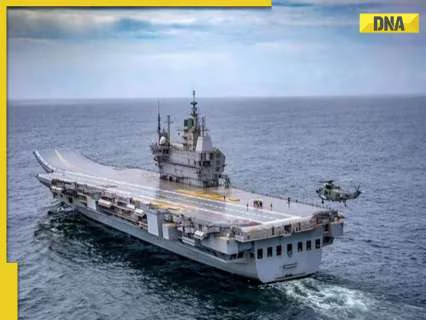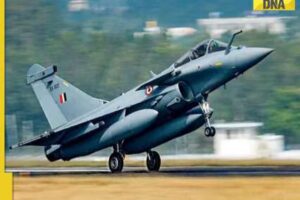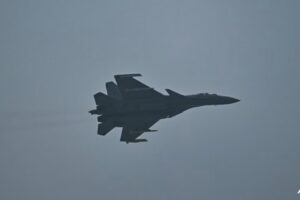
Continuing his 11-year tradition of spending Diwali with the armed forces, PM Modi called the soldiers ‘his family’ and expressed how fortunate he felt to celebrate the festival with them.
Prime Minister Narendra Modi celebrated Diwali on Monday, October 20th, with India’s naval personnel aboard INS Vikrant, the country’s first indigenous aircraft carrier, stationed off the coast of Goa and Karwar in the Arabian Sea. Continuing his 11-year tradition of spending Diwali with the armed forces, PM Modi called the soldiers “his family” and expressed how fortunate he felt to celebrate the festival with them.
Speaking to the Navy personnel, PM Modi described his night aboard INS Vikrant as an unforgettable experience filled with immense energy and enthusiasm. He was particularly moved when the soldiers sang patriotic songs describing Operation Sindoor, saying no words could fully convey what a soldier feels on the battlefield. The Prime Minister emphasized how INS Vikrant has become a powerful symbol of Atmanirbhar Bharat and Made in India, reflecting the nation’s pride and identity.
PM Modi made a pointed reference to how INS Vikrant gave Pakistan “sleepless nights” just by its name alone during Operation Sindoor. This was not mere rhetoric but a reflection of genuine strategic anxiety that gripped Islamabad when India’s mighty carrier moved into position in the Arabian Sea earlier this year.
Following the horrific Pahalgam terror attack on April 22, 2025, which killed 26 civilians, INS Vikrant moved into the Arabian Sea, positioning itself just 600 to 700 kilometers from Karachi. This was not a routine naval deployment but a clear signal of strength and readiness. With Pakistan already struggling with domestic unrest and economic strain, the carrier’s presence raised serious alarms in Islamabad. The deployment, known as Operation Sindoor, demonstrated India’s capability to project power and protect its interests in the region.
INS Vikrant is India’s first aircraft carrier built entirely at home and was commissioned in 2022 to strengthen the country’s naval power. With modern facilities and technology, the warship is called a “city on the move” because it has everything needed to operate independently at sea for long periods. It is named after the earlier INS Vikrant, which played a major role in the 1971 war against Pakistan that led to the creation of Bangladesh.
The sheer scale of INS Vikrant is breathtaking. It is the biggest warship ever built in India, measuring 262 meters long and 62 meters wide, making it India’s second aircraft carrier after INS Vikramaditya, which was made in Russia. The warship is about the length of two football fields placed one after another and as tall as an 18-story building. The hangar inside is huge, about the size of two Olympic-sized swimming pools.
The warship can carry up to 30 aircraft, including MiG-29K fighter jets and helicopters, and has space for around 1,600 crew members to live and work on board. It took more than 10 years to build and features a 16-bed hospital, 250 fuel tanks, and 2,400 compartments for different operations and crew needs. In December 2024, INS Vikrant achieved full operational status after getting its final clearance, and it is now part of the Western Naval Command, fully ready to carry out all naval missions and duties.
INS Vikrant weighs around 43,000 tonnes, has a top speed of 28 knots (about 52 kilometers per hour), and includes 8 kilometers of internal corridors. Nearly 76 percent of its parts were made in India, with major contributions from BEL, BHEL, L&T, Kirloskar, GRSE, and Wartsila India, along with over 100 MSMEs. The project cost about Rs 23,000 crore and faced many design and budget challenges, but it stands as a great success of Indian defense engineering.
What makes INS Vikrant truly fearsome is not just the carrier itself but the entire Carrier Battle Group that surrounds it. The carrier is protected by Barak-8 surface-to-air missiles and advanced radars like the EL/M-2248 MF-STAR, making it a self-sufficient fortress at sea. It carries MiG-29K fighter jets capable of striking targets over 800 kilometers away, helicopters like Kamov-31 for airborne surveillance, and HAL Dhruv for anti-submarine missions. The battle group includes Kolkata-class destroyers, Talwar-class frigates, and Kalvari-class submarines, all equipped with missiles that can strike deep, hard, and fast, leaving little chance for adversaries to respond effectively.
During Operation Sindoor, the moment INS Vikrant moved closer to Karachi, Pakistan increased naval patrols and claimed to deploy carrier-killer missiles. Indian sources confirm that Vikrant returned to Karwar Naval Base by April 26, possibly to avoid escalation. However, that temporary retreat did not reduce the threat. It underlined India’s readiness and restraint while demonstrating the capability to return with overwhelming force if necessary.
Pakistan’s real worry is India’s next move. A return of Vikrant’s battle group, supported by submarine-laid mines and a barrage of cruise missiles, could sink ships, block ports, and paralyze Karachi in hours. Pakistan’s naval defenses, limited to a few aging submarines and surface ships, cannot match this firepower. With BrahMos, Exocet, Klub-N, Barak-8, and Shtil-1 missiles at its command, the Indian Navy now holds the tools to deliver precise punishment if provoked.
When PM Modi commissioned INS Vikrant in 2022, the Indian Navy also bid farewell to one of the greatest symbols of colonial legacy by adopting a new naval ensign inspired by the valor and vision of Chhatrapati Shivaji Maharaj. This new ensign truly reflects India’s pride and identity as a maritime power that is no longer content to remain in the shadows.
INS Vikrant’s presence in the Arabian Sea, even briefly during Operation Sindoor, had a profound psychological and strategic impact. It reminded Pakistan and the world of India’s rising maritime power and its willingness to protect its interests with decisive action when necessary. The carrier stands as a testament to India’s growing indigenous defense capabilities and its determination to secure its waters and citizens.
As PM Modi celebrated Diwali with the brave sailors aboard this magnificent vessel, he acknowledged their dedication and sacrifice. The night he spent on INS Vikrant, watching soldiers sing patriotic songs and describe their experiences during Operation Sindoor, reminded the nation that behind every symbol of military might are men and women who stand ready to defend the country at any cost. INS Vikrant is not just a warship. It is a statement of intent, a symbol of self-reliance, and a promise that India will protect its people with strength, determination, and technological prowess built with Indian hands and Indian minds.
(The author of this article is a Defence, Aerospace & Political Analyst based in Bengaluru. He is also Director of ADD Engineering Components, India, Pvt. Ltd, a subsidiary of ADD Engineering GmbH, Germany. You can reach him at: girishlinganna@gmail.com)
(Disclaimer: The views expressed above are the author’s own and do not reflect those of DNA)





